To call art pornographic is taboo. To call any renaissance art pornographic is especially taboo because its era has the most prestige. People worldwide respect renaissance artists. And for centuries people have separated the ‘artistic’ and the ‘impressive’ from the ‘common’ and ‘vulgar’, with The Renaissance examples embodying the artistic, impressive and sublime. Even the definition of art and impressive depends on an inherited contrast to their contraries: what is forgettable, ugly or distasteful. To the contrary of shaming Renaissance art as actually pornographic, an examination of our definition of the pornographic, artistic, and erotic is timely. Such examination goes someway to show why Renaissance art matters now.
As with inherited genes which mutate, culture mutates and confuses what we inherit. To even write of the past is to betray it because looking back, from now, is always anachronistic. The word ‘pornography’ came centuries later, for instance, so when we look back we use our words rather than theirs. Yet there are regularities. Our anachronistic eyes change the past and categorise yes, but there are cases of the sublime, erotic, and pornographic dating from as far back as 1511. (And of course earlier, though that is not our present concern). Consider The Sistine Chapel ceiling, the most famous statue of David, and The Ways: The Sixteen Pleasures. These are first a religious paradise with cute cherubs, second a stately naked man, and third an erotic sex positions manual with poetry.
A continuum from the pure and idealistic to the impure and animalistic reigns in how we categorise renaissance art pieces. This misrepresents the more nuanced sexuality in art which renaissance artists valued. Yet this continuum representation is far from wholly misguided; Florentine intellectuals and patrons endorsed the spectrum themselves. In lieu of the always right customer and major reproducer of today, in Renaissance Italy the patron, the philosopher, and the artist were in creative dialogue.
Some Renaissance art was pornographic, some erotic, and some spiritual – yet all were sexual. Sexual by their renovated Plato’s definition. The theory for Renaissance art is analogous to the movement from evolutionary self-interest to the societal good; away from pleasure and gratification to good actions and worthy virtues symbolised in each work. Art for them functioned to pleasure, regulate and edify. To take beholders from animal impulses, to human reason. To God loving harmony. Current fashion replaces God with consensus, however, the striving for ideals remains. Galleries and museums would not be at their most frequented nor funded, if that were false, despite the confusion of audiences who often ask ‘what does it mean?’.
Funding art for the public became popular, along with Republican Democracy, again in Renaissance Florence. Banking had taken off, masterpieces were being made each week, and a new world order emerging.
Renaissance Florence at that time was the most powerful city in the world. As our London scene ideas are traceable to Renaissance Florence, so Florentine ideas are traceable to ancient Athens. The combination of Catholic and Platonist ideas shaped their concept of sexuality, which in turn shapes ours. The division of creative art-pieces into the pornographic, erotic, and the artistic is most discernible back then.
An intellectual tablemate of polymath Michelangelo and politician Lorenzo Di Medici changed history. His name? Marsilio Ficino. It was Ficino who published a translation of Plato in Latin, so every scholar in Europe could read and know The Master. Ficino reconciled the spectrum of sexual-beautiful-greater good in Plato with The Church. Take this excerpt from his translation of the Phaedrus and Symposium.
“So it was with the matter of this world. At the beginning it lay a formless chaos without the ornament of the forms; but, attracted by innate love, it turned toward the soul of the world and offered itself submissively to its influence. And thus by the mediation of this love, it received from the soul the ornament of all the forms which are to be seen in this world. And so out of chaos it became a world.”
As far as explanations go this was plausible, for the time. The relationship between people and the hypothetical (for Plato and Ficino truer) world of ideas is mediated through the material world; to become closer to the soul and forms, one must strive for love in the broadest sense. As mentioned, for Plato this meant sublimating sexuality to higher ideals. A spectrum, then, from sexuality to beauty to a unified love.
The metaphor Plato used was a “ladder of love”, with the lower the inferior. Plato speaks of ‘the correct man’, which every man should be. He says: “He will fall in love with the beauty of one individual body, so that his passion may give life to noble discourse”. He says “he must grasp that the beauties of the body are as nothing to the beauties of the soul”. Through edifying art the soul, he says, will grow wings; “by these the wing of the soul is nourished, and grows apace; but when fed upon evil and foulness and the opposite of the good, wastes away”.
The erotic and attractive is acceptable so long as it nurtures the wings and sublimates to higher ideals. Ficino popularised this idea. As art historian David Kristeller says: “the notion of Platonic love was taken over and adapted by many poets, notably by Lorenzo de Medici and Michelangelo”. Ficino’s “hook” metaphor appears in Michelangelo’s poems (trust me, it sounds better in Italian):
“I see I’m yours, and from afar I’m called
to draw nearer to that heaven whence I come,
and, with your beauties as bait, I reach you
like a fish on a hook pulled in by the line.”
Michelangelo reiterates the low to high, and physical hook to spiritual ideals metaphor. The “you” is notably ambiguous, referring to God’s and human love at the same time. Remarkably, these metaphors are not peculiar to the Renaissance. Social science supports the Halo Effect whereby lookers judge attractive people as better, as more virtuous. The higher being construed as better is a near-universal also. (Think of ‘lofty’ or ‘imposing’ and ‘top down’.) A linguistic product of humans personifying out from their upright bodies and the primitive higher status given to taller people – check out the heights of presidents – according to cognitive linguist George Lakoff. Just consider the form of David:
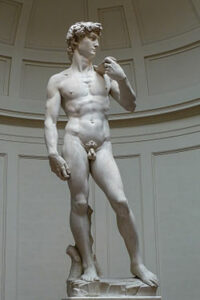
David is nude, youthful, and in the western ideal, beautiful. The perfectly upright posture signifies nobility, the toned muscles health, the elegant sway of right shoulder slightly lowered an almost casual confidence, the tension of raised left foot gives a lively impression of movement whilst the nonchalant handling of his slingshot weapon suggests calm and intelligence. Indeed, the virtues of intelligence, honesty, and courage are exemplified by his very nakedness: taking on a giant without protection demonstrates faith in his victory; faith makes him invulnerable. Yet while this can be read now the culturally specific meaning was context-dependent, as art historian Andrew Butterfield outlines: “David did not represent exclusively one specific ideal, whether republican liberty or Medicean rule, but instead a complex of political goods: divine aid, patriotic defense, right of conquest, justice, prosperity, and civic harmony”.
Aesthetic pleasure preceded the purpose of embodying noble ideas, so aesthetic pleasure is actually more objective than the values which are read into, rather than out of, such beautiful handiwork. We know David is impressive and then if we are sufficiently generous with our time we can realise how it endorses virtues of public life and advertises the good governance of Florence. In the manuscripts of the meeting which argued about where David should be raised, his nudity is tellingly taken for granted because David served to signify larger political aims and was used to associate the “divine aid” given to David with the divine aid given to Florence. At this particular time, Florence had become a tentative Republic. It wanted to celebrate the fact with majestic art.
Art historians, like Butterfield, have overestimated David’s political function above its aesthetic, then. Originally, David was made and funded for the Florence cathedral. Its political significations came later on, not deliberately. However, the representation of Florence as Good and Just subscribes to a neo-platonic view, just as the Church did the spiritual good and justice of God. Florence can only be represented as good and just by extension of David. Michelangelo’s work embodies goodness and justice through its naked and bold appearance.
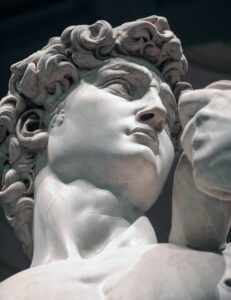
A close look at the face shows furrowed brows, attentive eyes, and craning neck. This places David in time. At the start of the parable where he calmly awaits Goliath. In line with the Michaelangelo’s “hook” and the Halo Effect, David is erotic and beautiful but such is sublimated into the “noble discourse” endorsed by Ficino and Plato and set in stone by Michelangelo. David is valued by the sixteenth-century Italian patron, artist and public alike because while it is aesthetically pleasing and possibly arousing it is justified as sublimation and instruction.
Being Biblical David and an embodiment of virtues rather than merely an arousing figure exemplifies the sixteenth-century difference between the erotic and the pornographic.
Arguably, the other Davids (some may be shocked to learn there are others) are less revered and less known not simply because Michelangelo’s is more technical, but David better embodies the values of Florence, Church and Neoplatonism. Most probably since the commission, audience, and impressive style in marble was remarkably public and a matter of intelligentsia and town planning concern.
The eroticism of nudes and portrayal of beautifully idealised bodies appear to reinforce the worthy virtues of courage, truth, charity and innocence. The tension between sexual desire and higher ideals is notable in the beautiful Virgin Mary, also. For instance:
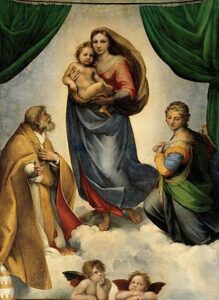
The sixteenth century Madonna is mathematically proportional and baby Jesus exaggeratedly cute; the severity of expression contrasts their attraction with their thoughts—their soulful eyes. Because both figures are aesthetically pleasurable, Madonna and Jesus are paid more attention, and so too are the messages of good-will. With the halo-effect, their formal beauty encourages the attribution of virtues.
The Catholic influence on sexuality has it that while David can be naked and exemplify virtues, it is the absence or concealment of eroticism in the Madonna which most contributes to her goodness – rosy-cheeked, innocent but earnest, eroticism is sidelined into ‘pure’ beauty. In this case, sexuality is representationally sublimated into a love for God and Jesus and figured in a (mythic) esteemed absence as virginity, chastity. The beauty and attenuation of sexuality in the Sistine Madonna act to transfer the baser impulses of the audience and inspire Neoplatonic ideas and Godly love, in much the same way that The Madonna and Jesus are archetypal models of such sublimation in their biblical narratives.
Sexuality does play a necessary sublimative role in religious or republican art for Raphael and Michelangelo, in the erotic David and the beauty of the Madonna; whereas Titian, for example, uses the erotic and beautiful for sheer pleasure, not for ethical redistribution; Titian’s paintings better suit the word ‘pornography’ than the others. Consider this:
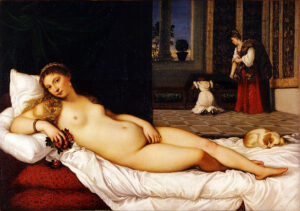
The goddess Venus is depicted. Venus of Urbino is the title of the painting yet without the title one would never know it was Venus. Here there is no allegory or parable or sublimation even making use of myth. This painting has a different function to that of David and The Sistine Madonna: to arouse. The “hook” and halo effect are reasons for Michelangelo and Raphael, but excuses for Titian. What is rationalised as a mythic work of a Goddess has all the domesticity of a mortal. Consider the pet dog, the fleeting nature of beauty symbolised in the roses she holds (not the immortality of an immortal being in heavens), and the anonymous maid and maiden figuring in the background. For an Italian audience, the Greek subject is even put into the Italianate countryside. She gazes askance and invitingly for men. Not for God nor Florence.
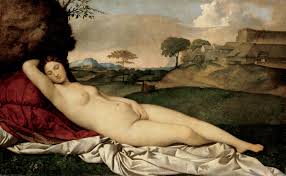
The earlier painting of Venus by Giorgione and Titian uses mythology to rationalise pornography . Indeed it is closer to its rationalisation since it is fitting to have a Goddess outside but still – it is pornographic. The Venus of Sleeping Venus, the earlier painting of the two, is very human once again. Depicted sleeping she, a goddess, is passive and implausibly strewn across the ground. For the pleasure of men, or what is called in academia ‘the male gaze’.
This divergence from theological and platonic love becomes obvious looking at the biography of Titian. While the nudes pretend to be, and were justified by, mythological subject-matter there is no sublimation to God or Platonic ideals present; instead The Venus of Urbino is actually an imitation of reality rather than the form of beauty: a portrait of Angela del Moro, a Venetian courtesan and Titian’s dining–and probably more–partner. An actual portrait of a beautiful lover, most likely, is not working to edify. The purpose of the artwork is sexual pleasure. This is evident even in its commission for a wedding box – it was to serve as a “model” to the Duke Commissioner’s young bride. If there is a message in that, it is probably for an actual woman to provide as much sexual pleasure as the painted nude; a very different meaning from the sublimated erotic in the prior works of Raphael and Michelangelo.
My categorising of Titian’s nudes as pornography may jar with (what Walter Benjamin called) the aura of art, the sanctity accorded to technically brilliant works, especially of the Renaissance, but the anachronism is actually our desexualised, time attenuated, aura making – not the label of pornography. Take, for instance, the recorded remarks of Titian’s contemporaries, like Dolce, who remarks how his works – in this case the painting of Venus and Adonis – “stirred the blood”. Dolce compares Titian’s achievement to the Greek myth of a sculpture so arousing and lifelike it made its viewer ejaculate: “If a marble statue by the stimuli of its beauty could so penetrate to the marrow a young man that he stained himself, then, what must she do who is of flesh, who is beauty personified and appears to be breathing”.
Here Titian’s work is praised purely for the competitive element of its arousal – the success of Sansovino’s classical statue of the story was that it aroused to such an extent as to cause ejaculation. Dolce terms Venus and Adonis, as (notably by medium) even more arousing. She is even described as real: “what must she do who is of flesh”, because it renders a reality that is even more arousing than past masters had, he seems to believe, achieved. What makes Titian’s works so valued and widespread is not the nobility or a Christian or even Neoplatonist content but the illicit and pleasurable nudity.
The moneymaking thrift of working-class-born Titian may have even been a factor in his painting and selling the most marketable paintings of all: pornography. Notably, Titian’s paintings were for private use foremost and somewhat tinged by taboo, whereas David and The Sistine Madonna were for public architecture.
The art that is erotic (may arouse) sexually in public is justified by its higher meaning – whether God or Neoplatonic ideals. It always refers to lust and love; that is physical and spiritual loves. Whereas the paintings of Titian represent the physically beautiful and lust without working such physical beauty and lust to an ideal beauty and ideal love. The Platonic love that was endorsed by the Florentine scholars is missing and the “hook” of lust and physical beauty remains in-so-far-as the paintings were popular and paid attention, but never culminates in reeling to better “heavenly” as Michelangelo aspires in his poetry. Rather than “you” having a double meaning as a love for a physical person and love for ideas and God, Titian’s is a single-focused-meaning. In antagonism to the philosophic sense endorsed by the Platonic academy who would – arguably – deem his work to not truly be Art with Love or Eros, or even moral, but lust merely.
To conclude, the Catholic Church, Neoplatonism and sexual human nature formed the role of art in Europe. First, there are works which conform to the sublimating role of the erotic in art. Namely taming sexual impulses to higher ideals and a soulful yet rational love for God, as recommended by the Platonic academy and the treatises on love such intelligentsia inspired. Works like the womanly example The Sistine Madonna and manly David. These artworks are erotic because they can arouse and are beautiful bodies, but arousal is not their ends but their means. Second, there is the pornographic art which works in dis-continuous influence of the Catholic Church and Neoplatonism not to sublimate sexuality but to gratify it. Consider The Sleeping Venus or The Venus of Urbino which uses mythology: the figure of Venus is a plausible excuse to paint pornography. In such pornography, the taboo propagated by the Catholic Church and the sublimate logic around female nakedness finds a recourse in mythology which satisfies human appetites.
The Catholic Church, Neoplatonism and sexual human nature formed the role of art in sixteenth Europe whether it was in a continuous influence of the philosophical logic of sublimation or a case of discontinuous influence, or simply a satisfaction of artist-expressed and audience-satisfied sexual desires. The rationale between high and low, and between artistic and vulgar endure today. Perhaps we ought to embrace more of the Platonist logic for art. Perhaps art ought to function not to merely represent ideas or arouse experiences – but to advertise ideals. Art now aims for the intellect through difficulty or to pleasure the senses; what we lack now and need most is the combination of both.

